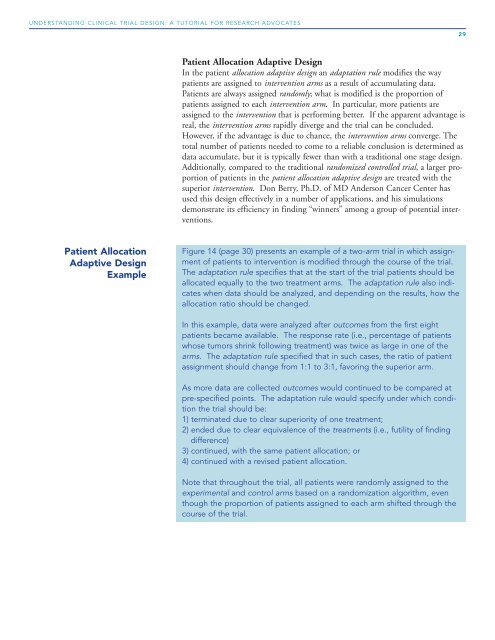Understanding Clinical Trial Design - Research Advocacy Network
Understanding Clinical Trial Design - Research Advocacy Network
Understanding Clinical Trial Design - Research Advocacy Network
Create successful ePaper yourself
Turn your PDF publications into a flip-book with our unique Google optimized e-Paper software.
UNDERSTANDING CLINICAL TRIAL DESIGN: A TUTORIAL FOR RESEARCH ADVOCATES<br />
Patient Allocation<br />
Adaptive <strong>Design</strong><br />
Example<br />
Patient Allocation Adaptive <strong>Design</strong><br />
In the patient allocation adaptive design an adaptation rule modifies the way<br />
patients are assigned to intervention arms as a result of accumulating data.<br />
Patients are always assigned randomly; what is modified is the proportion of<br />
patients assigned to each intervention arm. In particular, more patients are<br />
assigned to the intervention that is performing better. If the apparent advantage is<br />
real, the intervention arms rapidly diverge and the trial can be concluded.<br />
However, if the advantage is due to chance, the intervention arms converge. The<br />
total number of patients needed to come to a reliable conclusion is determined as<br />
data accumulate, but it is typically fewer than with a traditional one stage design.<br />
Additionally, compared to the traditional randomized controlled trial, a larger proportion<br />
of patients in the patient allocation adaptive design are treated with the<br />
superior intervention. Don Berry, Ph.D. of MD Anderson Cancer Center has<br />
used this design effectively in a number of applications, and his simulations<br />
demonstrate its efficiency in finding “winners” among a group of potential interventions.<br />
Figure 14 (page 30) presents an example of a two-arm trial in which assignment<br />
of patients to intervention is modified through the course of the trial.<br />
The adaptation rule specifies that at the start of the trial patients should be<br />
allocated equally to the two treatment arms. The adaptation rule also indicates<br />
when data should be analyzed, and depending on the results, how the<br />
allocation ratio should be changed.<br />
In this example, data were analyzed after outcomes from the first eight<br />
patients became available. The response rate (i.e., percentage of patients<br />
whose tumors shrink following treatment) was twice as large in one of the<br />
arms. The adaptation rule specified that in such cases, the ratio of patient<br />
assignment should change from 1:1 to 3:1, favoring the superior arm.<br />
As more data are collected outcomes would continued to be compared at<br />
pre-specified points. The adaptation rule would specify under which condition<br />
the trial should be:<br />
1) terminated due to clear superiority of one treatment;<br />
2) ended due to clear equivalence of the treatments (i.e., futility of finding<br />
difference)<br />
3) continued, with the same patient allocation; or<br />
4) continued with a revised patient allocation.<br />
Note that throughout the trial, all patients were randomly assigned to the<br />
experimental and control arms based on a randomization algorithm, even<br />
though the proportion of patients assigned to each arm shifted through the<br />
course of the trial.<br />
29


